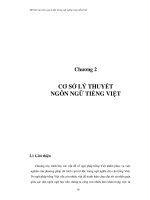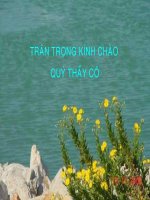TARIFFS AND TARIFF STRUCTURES
Bạn đang xem bản rút gọn của tài liệu. Xem và tải ngay bản đầy đủ của tài liệu tại đây (253.23 KB, 65 trang )
SOUTH EAST ASIA
TRADE POLICY
TRAINING NETWORK
SEATRANET ADVANCED COURSE
NON AGRICULTURAL MARKET ACCESS
(NAMA)
Module 2
TARIFFS AND
TARIFF STRUCTURES
1
SOUTH EAST ASIA
TRADE POLICY
TRAINING NETWORK
Outline of Module 2
1.
The WTO and Tariffs
2.
What is a Tariff?
3.
Elements of Tariff Structure
4.
Tariffs in Modern Trade Policy
5.
Developing Countries and the WTO
2
SOUTH EAST ASIA
TRADE POLICY
TRAINING NETWORK
1. The WTO and Tariffs
3
SOUTH EAST ASIA
TRADE POLICY
TRAINING NETWORK
The WTO and Tariffs
• The WTO is based on five easy to understand principles :
- Trade Without discrimination
- Freer trade, gradually, through negotiations
- Predictability, through binding and transparency
- Promoting fair competition
- Encouraging development and economic reform
4
SOUTH EAST ASIA
TRADE POLICY
TRAINING NETWORK
Trade Without
Discrimination
• Most favoured Nation (MFN)
treatment
–
Embodied in GATT Article 1
– Must treat all WTO members the same or as well as the most
favoured member
– Prohibits discrimination at the border based on the source of a
product
5
SOUTH EAST ASIA
TRADE POLICY
TRAINING NETWORK
Trade Without
Discrimination
• A few MFN exceptions are permitted
- Goods imported under free trade agreements
(Article XXIV)
- General waivers (Article XXV)
- Better access for developing countries
- To counteract unfairly traded products
6
SOUTH EAST ASIA
TRADE POLICY
TRAINING NETWORK
Trade Without
Discrimination
• National Treatment
– Embodied in GATT Article III
–
Equal Treatment for domestic and foreign
after they have entered the market.
goods
7
SOUTH EAST ASIA
TRADE POLICY
TRAINING NETWORK
Trade Without
Discrimination
• A few National Treatment exceptions are permitted
– Article XX provides for general exceptions based on public
morals, human and animal health, etc.
– Article XXI provides for exceptions based on national security
8
SOUTH EAST ASIA
TRADE POLICY
TRAINING NETWORK
Predictability Through Binding and
Transparency
• Binding: Each WTO member publishes its
schedule of bound tariffs
– Subject to some specific exceptions a “bound” tariff is a
contractual undertaking: It is the maximum tariff permitted
based on the GATT. Actual (“applied”) tariffs can be lower,
however.
• Transparency is now a basic principle of many
WTO agreements, but greatest source is
through the Trade Policy Review.
9
SOUTH EAST ASIA
TRADE POLICY
TRAINING NETWORK
•
Encouraging Development and
Economic Reform
Part IV of the GATT deals specifically
with Trade and Development
– The Enabling Clause provides for discrimination in
favour of developing and least developed countries.
– Interests of developing countries are clearly taken
into account in GATT agreements and individual
articles.
10
SOUTH EAST ASIA
TRADE POLICY
TRAINING NETWORK
2. What is a Tariff?
11
SOUTH EAST ASIA
TRADE POLICY
TRAINING NETWORK
What is a Tariff?
• A tariff is a tax on an imported good
when it crosses the border.
– Tariffs can sometimes be applied to exports too, but this is much
less common.
12
SOUTH EAST ASIA
TRADE POLICY
TRAINING NETWORK
What is a Tariff?
• Tariffs have four principle functions:
– A source of government revenue
– Protection of domestic industry
– Punitive function to remedy trade distortions
– As negotiating tool to reduce tariffs of others
13
SOUTH EAST ASIA
TRADE POLICY
TRAINING NETWORK
Other border measures
• Quantitative restrictions (QR) used to be the most
common alternative to tariffs.
• Article XI of the GATT states:
“No prohibitions or restrictions other than duties, taxes
or other charges … shall be instituted or maintained by
any member”
• This clearly bans QRs
14
SOUTH EAST ASIA
TRADE POLICY
TRAINING NETWORK
Why are Tariffs preferred
over QRs?
• Tariffs are transparent and predictable.
– QR lead to economic rents depending on how the quotas are
allocated.
• QRs do not reflect changes in prices or foreign
exchange or tastes
• Negotiation processes for reduction of bound tariffs are
easily managed
15
SOUTH EAST ASIA
TRADE POLICY
TRAINING NETWORK
Why are Tariffs preferred
over QRs ?
• Tariffs lead to greater economic efficiency.
• Quotas are often linked to corruption.
• QRs are do not generate revenue for the government.
16
SOUTH EAST ASIA
TRADE POLICY
TRAINING NETWORK
•
Types of Tariffs
There are four basic types – they differ in
how the tariff is computed.
1.
2.
3.
4.
Ad valorem tariff
Specific tariff
Compound tariff
Mixed tariff
17
SOUTH EAST ASIA
TRADE POLICY
TRAINING NETWORK
Types of Tariffs
• Ad valorem tariff is a fixed percentage of the
value of the imported product (“ad valorem” is
Latin for “in proportion to the value”)
18
SOUTH EAST ASIA
TRADE POLICY
TRAINING NETWORK
Types of Tariffs
• Specific tariff is a fixed charge per unit of
imports
19
SOUTH EAST ASIA
TRADE POLICY
TRAINING NETWORK
Types of Tariffs
• Compound tariff is one which incorporates both
an ad valorem and a specific tariff
20
SOUTH EAST ASIA
TRADE POLICY
TRAINING NETWORK
Types of Tariffs
• Mixed tariff is both ad valorem and specific
tariffs and the one producing the highest (or in
other cases the lowest tariff) is to be used.
21
SOUTH EAST ASIA
TRADE POLICY
TRAINING NETWORK
Types of Tariffs
• Ad valorem and specific tariffs are normally
simple to understand and are transparent
• There are two “other” types of tariffs that are
more complex:
– Component based tariff
– Content based tariff
22
SOUTH EAST ASIA
TRADE POLICY
TRAINING NETWORK
Tariff examples
Component: based on an ad valorem tariff on one
component of the product and a specific tariff on
another
Example: In the US system a wristwatch imported into
the US faces an ad valorem tariff on the case and strap
as well as a specific tariff of 5.1 cents and a 5.3% ad
valorem tariff on the battery.
23
SOUTH EAST ASIA
TRADE POLICY
TRAINING NETWORK
Tariff examples
Content based tariff is based on a specific material content
Example: a tariff on 0.55 cents /kg on the manganese
content
24
SOUTH EAST ASIA
TRADE POLICY
TRAINING NETWORK
•
Types of Tariffs Cont
“Tariff Rate Quotas” (TRQ) continue to exist in
Agricultural trade.
– A TRQ permits the importation of a certain volume or value of a
specific product at a fixed rate.
– All imports greater than that volume or value face a higher
tariff.
25









